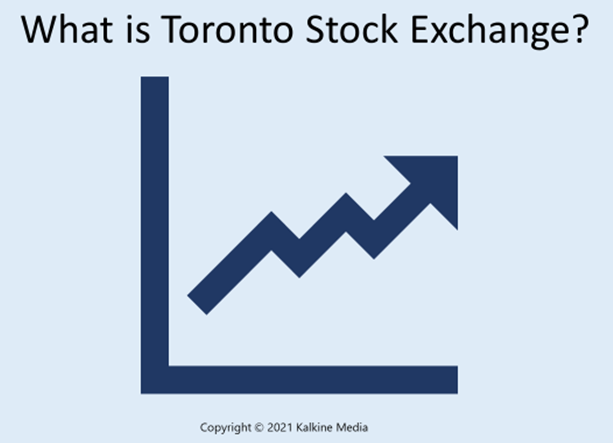What is the Toronto Stock Exchange (TSX)?
The Toronto Stock Exchange (TSX) is said to be the largest of its kind in Canada. Founded in 1861, the Canadian stock exchange has its headquarters, as the name suggests, in the city of Toronto.
In 1878, the TSX was established officially under the name ‘TSE’, or Toronto Stock Exchange. Its trading floor closed in 1997 and became a fully electronic exchange.
In 2002, post rebranding, it was known as TSX. As on December 10, 2007, TSX Group acquired Montreal Exchange Inc and formed TMX Group.
All the transactions on it take place in Canadian dollars (CAD or C$).
It is said to have more than 1,500 companies listed on it, comprising various sectors such as mining, financial, energy, real estate, technology, etc. It presently ranks in the third position on The World Federation of Exchanges.
Some of the traded instruments on the TSX are:
- Shares in companies: It is a financial instrument having equity ownership of a company.
- Exchange-traded products: Exchange-traded products (ETPs) offer a safe and cost-effective way to diversify the portfolio.
- Investment trusts: It is a financial instrument constituted as public companies and are close-ended funds.
- Bonds: It is a fixed income instrument representing a loan made by the investor to a company.
- Commodities: It is an investment used in commerce to buy, sell, or trade. The items include gold, silver, livestock, natural gas, etc.
- Futures: It is a derivative financial contract that obliges the parties to transact the security at a prearranged date and cost in future.
- Options: It gives an investor right to sell and buy the stock at an agreed price and date.

Summary
- The Toronto Stock Exchange (TSX) is a Canadian stock exchange founded in 1861 and located in Toronto, Canada.
- In 2007, TSX Group acquired Montreal Exchange Inc and formed TMX Group.
- All transactions take place in Canadian dollars.
Frequently Asked Questions (FAQs)
- When does the Toronto Stock Exchange operate?
The Toronto Stock Exchange operates from Monday to Friday between 9:30AM EST to 4:00PM EST, except on statutory holidays. Trading orders can be entered during the pre-open hours between 7:00AM and 9:30AM EST, but they get executed in the trading hours.
- What opportunities are offered by the TSX to international US based companies?
Some of the advantages extended to international firms by the Canadian market and the TSX are:
- Gateway to North American Capital: The public companies listed on TSX have access to North American capital markets, the world’s largest capital pools. TSX provides a broad investor base providing liquidity and access points to US and Canadian markets seeking expansion and growth.
- Leveraging economic strength: The TSX is a significant world-class market, as reflected in the broader stability of the Canadian economy. According to the Economist Intelligence Unit in G20, Canada is the top country to do start an enterprise in. Its economy is diversified in technology, manufacturing, and financial services.
- Gateway to North American institutional Capital: On the TSX, firms can reach investors across North America who trade directly in the country.
- What are the methods of listing on TSX?
The TSX provides a flexible approach to the companies willing to go public or raise public capital. Companies can choose an appropriate method of going public on TSX post discussing with its advisors.
- Initial Public Offering: It requires completing an application for listing and prospectus filing with the Canadian security regulators as applicable.
- Reverse Takeover: It allows a private company to get listed.
- Qualifying transaction or acquisition: It will enable the capital pool companies or special purpose acquisition companies, which have cash in their balance sheets, to provide a pathway to take companies public.
- Direct listing: If the companies are already publicly listed and qualify, the requirements at TSX can directly get listed on TSX.
- How does listing on TSX increases brand visibility?
The TMX Group offers a publicly listed company numerous and complementary ways of its branding:
- Digital display in Downtown Toronto
- Display on social feeds
- The market open/close
- How to invest in TSX stocks?
There are two methods of investing in TSX stocks:
- Interlinked stocks: These are the stocks that are dually listed on a Canadian exchange like the TSX and US exchange like NASDAQ or NYSE. The benefit of these stocks is they can be bought in U.S. dollars (US$) too. Most of the interlinked stocks have the same trading ticker in both Canadian and U.S. stock exchanges.
- Mutual Funds and Exchange-traded funds (ETFs): These are another popular method of investing in Canadian securities and are purchased either through an online account or a broker. Before investing, it is advised to evaluate the stock in terms of risk tolerance, investment goals and any tax implications for an overseas investor or trader, if any.
- What is the main difference between TSX and TSXV?
The TSXV provides a platform to gain capital access for early-stage and emerging companies via public venture growth. As a result, it helps in facilitating the company’s growth. In addition, the TSXV has fewer minimum listing requirements when compared to TSX.
The TSXV offers a company to go public through two different tiers:
- Tier 1: It is reserved for advanced issuers and has financial resources. This is the stage from where a company starts its journey.
- Tier 2: The majority of the issuers trade in this tier as it requires few listing requirements.
 Please wait processing your request...
Please wait processing your request...